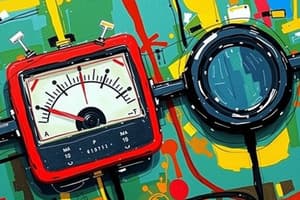Podcast
Questions and Answers
How is electrical resistance defined scientifically?
How is electrical resistance defined scientifically?
- As the ratio of voltage to current flowing through the conductor. (correct)
- As the total voltage applied across a conductor.
- As the total amount of free electrons in a conductor.
- As the ratio of current to voltage.
What does conductance signify in relation to electrical resistance?
What does conductance signify in relation to electrical resistance?
- It is independent of the material's physical state.
- It is equivalent to the voltage across a conductor.
- It is the total resistance of all materials present.
- It indicates how easily electric current can flow through a conductor. (correct)
Which unit is used to measure electrical resistance?
Which unit is used to measure electrical resistance?
- Amperes
- Volts
- Siemens
- Ohms (correct)
What is primarily responsible for electrical resistance in conductors?
What is primarily responsible for electrical resistance in conductors?
According to Ohm's law, how are voltage and current related?
According to Ohm's law, how are voltage and current related?
What does the term 'conductance' denote?
What does the term 'conductance' denote?
How does the length of a conductor affect its electrical resistance?
How does the length of a conductor affect its electrical resistance?
What happens to the resistance of a conductor when its cross-sectional area increases?
What happens to the resistance of a conductor when its cross-sectional area increases?
Which type of resistance is defined as the ratio between voltage and current for direct current?
Which type of resistance is defined as the ratio between voltage and current for direct current?
What effect does temperature have on the electrical resistance of a conductor?
What effect does temperature have on the electrical resistance of a conductor?
What quantity is indicated by the slope of the current-voltage plot for an ohmic conductor?
What quantity is indicated by the slope of the current-voltage plot for an ohmic conductor?
How is dynamic resistance defined in the context of alternating current?
How is dynamic resistance defined in the context of alternating current?
What effect does decreasing resistance in an electric circuit have on current flow?
What effect does decreasing resistance in an electric circuit have on current flow?
Which application is NOT based on Joule's law of heating?
Which application is NOT based on Joule's law of heating?
Which of the following correctly describes Joule's law of heating?
Which of the following correctly describes Joule's law of heating?
How does the filament in incandescent light bulbs behave according to Joule's law?
How does the filament in incandescent light bulbs behave according to Joule's law?
In the context of electric fans, what role does the regulator play?
In the context of electric fans, what role does the regulator play?
What happens when the resistance in a resistance oven is high?
What happens when the resistance in a resistance oven is high?
Which statement about Joule's law is correct?
Which statement about Joule's law is correct?
What is the result of high resistance when using electric heaters?
What is the result of high resistance when using electric heaters?
Flashcards are hidden until you start studying
Study Notes
Electrical Resistance
- Electrical resistance signifies a conductor's opposition to electrical current flow.
- Defined as the ratio of voltage applied to the current through the conductor.
- Measured in ohms (Ω), symbolized by the Greek letter Omega.
- Conductance is the reciprocal of resistance, defined as current divided by voltage, measured in siemens (S).
Causes of Electrical Resistance
- Conductors contain free electrons that randomly move and collide with fixed atomic structure, causing resistance.
- Resistance arises due to these collisions, impeding the flow of electrons.
Ohm's Law
- Establishes a fundamental relationship between voltage (V), current (I), and resistance (R).
- Voltage is directly proportional to current, with resistance being the constant of proportionality.
- Materials following Ohm's law are termed ohmic, exhibiting a linear current-voltage relationship.
Variables Affecting Electrical Resistance
- Resistance directly proportional to the length of the conductor; longer conductors have higher resistance.
- Resistance inversely proportional to the cross-sectional area; larger areas reduce resistance.
- Resistivity (ρ), a material property, is crucial, defined as resistance with unit length and area.
- SI unit of resistivity is ohm-metre (Ω·m).
Effect of Temperature on Electrical Resistance
- Resistance and resistivity increase with temperature, following specific temperature coefficient formulas.
- Represents the rate of change in resistivity with temperature adjustments.
Types of Electrical Resistance
- Static Resistance (DC Resistance): Resistance encountered by direct current, constant at given temperature; defined by voltage/current ratio.
- Dynamic Resistance (AC Resistance): Resistance varying with alternating current, defined by the ratio of change in voltage to change in current.
Role of Electrical Resistance in Circuits
- Despite acting as a barrier, resistance controls current flow in circuits, essential for regulation.
- Example: Voltage decreases lead to higher current flow with lower resistance settings, influencing devices such as fans.
Joule's Law of Heating
- Current flow through a resistor generates heat due to resistance, converting electrical energy to thermal energy.
- Higher resistance results in increased heat production.
- Applications include:
- Incandescent Bulbs: High-resistance filaments glow when heated.
- Resistance Ovens: Current flows through resistance to heat and cook.
- Electric Heaters: Conducting materials heat surroundings through Joule's heating principle.
Studying That Suits You
Use AI to generate personalized quizzes and flashcards to suit your learning preferences.




